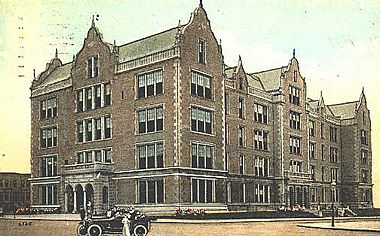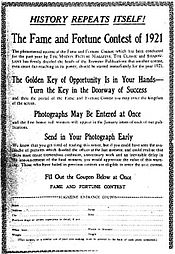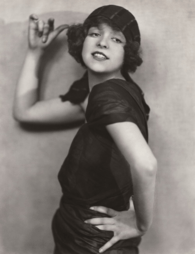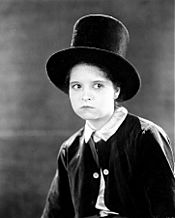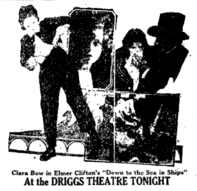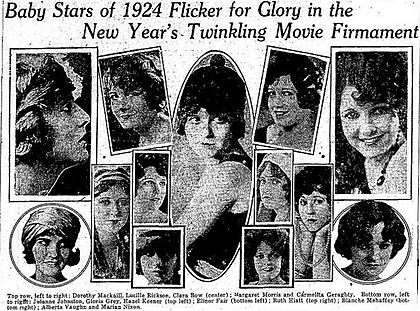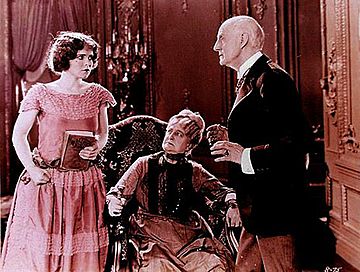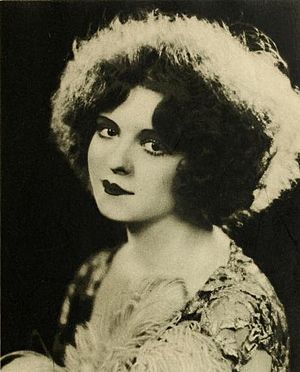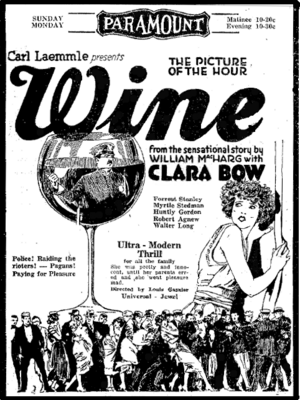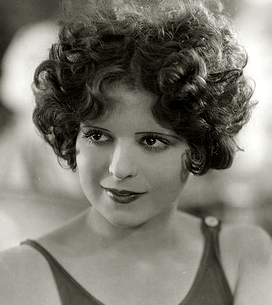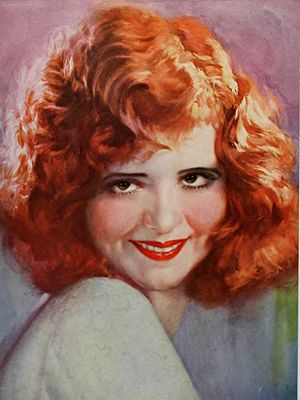Clara Bow facts for kids
Quick facts for kids
Clara Bow
|
|
|---|---|
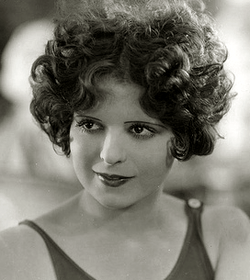
in Rough House Rosie (1927)
|
|
| Born |
Clara Gordon Bow
July 29, 1905 |
| Died | September 27, 1965 (aged 60) Culver City, California, U.S.
|
| Resting place | Forest Lawn Memorial Park, Glendale |
| Nationality | American |
| Occupation | Actress |
| Years active | 1921–1933 |
| Known for | The original "It" Girl |
| Spouse(s) |
Rex Bell
(m. 1931; died 1962) |
| Children | 2 |
Clara Gordon Bow (born July 29, 1905 – died September 27, 1965) was a famous American actress. She became a huge star in silent films during the 1920s. She also successfully acted in "talkies" (movies with sound) after 1927.
Clara Bow became globally famous for her role as a brave shopgirl in the 1927 film It. This movie earned her the nickname "The It Girl". She became a symbol of the exciting 1920s, also known as the Roaring Twenties.
She acted in 46 silent films and 11 talkies. Some of her big hits include Mantrap (1926), It (1927), and Wings (1927). She was the top box-office star in 1928 and 1929. In 1927 and 1930, she was the second most popular star. At her peak, she received over 45,000 fan letters in just one month!
The cartoon character Betty Boop, created by Max Fleischer, was partly inspired by Clara Bow. After marrying actor Rex Bell in 1931, Clara Bow stopped acting. She became a rancher in Nevada. Her last film, Hoop-La, was released in 1933. She passed away from a heart attack in September 1965, at the age of 60.
Contents
Early Life and Childhood
Clara Bow was born in Prospect Heights, Brooklyn, New York City, in 1905. She was the third child of her parents. Sadly, her two older sisters had died as babies. Her mother, Sarah Frances Bow, had been warned by doctors not to get pregnant again because it was too risky. Despite this, Clara was born.
Clara's parents came from English and Scots-Irish families who had moved to America. Her father, Robert Walter Bow, often struggled to find work. Because of this, Clara's family moved 14 times between 1905 and 1923.
Clara's mother had a serious head injury when she was 16. This led to her having epilepsy and other health issues. From a young age, Clara learned to care for her mother during difficult times. Her mother passed away in 1923 when Clara was 17.
Clara went to several public schools in New York City. She often felt shy around other girls. They sometimes teased her because her clothes were worn out and her hair was "carrot-top" red. Clara remembered, "I never had any clothes... And lots of time didn't have anything to eat."
From first grade, Clara preferred playing with boys. In 1919, she started attending Bay Ridge High School for Girls. Clara loved sports and was very athletic. She even planned to become an athletics instructor. She won five medals in track events. Her cousin, Homer Baker, who was a national champion runner, helped train her.
Becoming an Actress
In the early 1920s, about 50 million Americans went to the movies every week. As Clara grew up, she found comfort in movies. She said, "For the first time in my life I knew there was beauty in the world." She felt a strong connection to actors on screen. She would go home and pretend to be the characters she had seen. By age 16, Clara knew she wanted to be a movie actress.
Even though her mother didn't want her to act, Clara's father supported her. In 1921, Clara entered a national acting contest called "Fame and Fortune." The winners of this contest often found work in movies. Clara won the contest! The judges were very impressed with her. They said she was "full of confidence, determination and ambition" and had a "genuine spark of divine fire."
Clara won an evening gown and a silver trophy. The magazine promised to help her get a role in films. At first, nothing happened. Clara's father told her to keep visiting the publisher's office. Eventually, she met director Christy Cabanne. He cast her in Beyond the Rainbow, filmed in New York City in late 1921. Clara filmed five scenes and impressed the director with her ability to cry on cue. However, her scenes were cut from the final movie.
Early Silent Films
Clara kept trying to get acting parts. She was often told she was too young or too small. Finally, director Elmer Clifton needed a tomboy for his movie Down to the Sea in Ships. He saw Clara in a magazine and sent for her. Clara got the part and was paid $50 a week.
Down to the Sea in Ships was filmed in New Bedford, Massachusetts. It showed life in a whale-hunting community. The movie premiered in September 1922 and was released to everyone in March 1923. Even though Clara was not the main star, she stood out. Critics praised her, saying she would "undoubtedly gain fame."
By late 1923, Clara was chosen as the most successful of the 1924 WAMPAS Baby Stars. This was a group of young actresses chosen for their potential. She got a part in The Daring Years (1923), where she learned about makeup from actress Mary Carr. That summer, she played a tomboy in Grit, a story about young people and crime. The director, Frank Tuttle, later said Clara was "dynamite, full of nervous energy and vitality."
Moving to Hollywood
In 1923, Clara was offered a contract with a Hollywood studio called Preferred Pictures. She would get $50 a week. On July 22, 1923, Clara left New York and moved to Hollywood.
Her first Hollywood movie was Maytime. Before it was even finished, she was given a lead role in another big film. She also co-starred in Black Oxen and Painted People. For Black Oxen, she played a high-society flapper. The director said Clara was the perfect "mischievous, pretty, aggressive" flapper.
In 1924, Clara appeared in eight movies. In 1925, she appeared in 14 movies! Motion Picture Classic magazine said she was "alarming symptoms of becoming the sensation of the year." Clara worked very hard, sometimes on two or three movies at once. She said she would be "worn out and cry myself to sleep from sheer fatigue after 18 hours a day." But she was glad for the experience.
Clara's studio, Preferred Pictures, would loan her out to other producers for a lot of money. But they paid Clara much less. In 1925, Preferred Pictures went bankrupt. However, Clara's talent was so great that the studio's owner, Budd Schulberg, was hired by Paramount Pictures. He was hired mainly because he had Clara Bow under contract.
The Plastic Age was Clara's last movie for Preferred Pictures and her biggest hit so far. She played a college girl named Cynthia Day. This movie was filmed at Pomona College in 1925. Clara also started dating her co-star, Gilbert Roland.
Paramount Pictures Star
Clara Bow was known for her amazing personality and energy. Director Victor Fleming compared her to a Stradivarius violin, saying, "Touch her, and she responded with genius." Director William Wellman said, "Movie stardom isn't acting ability—its personality and temperament... She was mad and crazy, but WHAT a personality!"
In 1926, Clara appeared in eight movies. Five were for Paramount, including Kid Boots with Eddie Cantor. She also starred in the drama Dancing Mothers, playing a lively upper-class daughter. Critics loved her performance.
In April 1926, Clara signed her first contract with Paramount. She would earn $750 a week. By August 1926, she signed a five-year deal with Paramount. Her salary would start at $1700 a week and go up to $4000 a week.
In 1927, Clara starred in six Paramount movies. One of them was It. In this Cinderella-like story, a poor shop-girl named Betty Lou Spence (played by Clara) wins the heart of her boss. The movie said that a special quality called "It" made it happen. This film gave Clara her famous nickname, "The 'It' Girl."
Clara also starred in Wings in 1927. This was a war movie that was changed to fit her, as she was Paramount's biggest star. Wings went on to win the very first Academy Award for Best Picture. In 1928, Clara appeared in four more Paramount movies, but these films are now lost.
Transition to Sound Films
When movies started having sound, called "talkies", Clara Bow continued to be a huge star. Her first talkies were The Wild Party, Dangerous Curves, and The Saturday Night Kid, all released in 1929. She remained the top box-office star in Hollywood. Her voice and her Brooklyn accent were not a problem for her fans or the studio.
In 1930, Clara was the second most popular star, just behind Joan Crawford. She starred in movies like Paramount on Parade, True to the Navy, and Love Among the Millionaires. In 1931, she was still among the top five box-office stars. However, the pressure of fame, public attention, and too much work started to affect Clara's health.
In June 1931, Clara left Hollywood for Rex Bell's ranch in Nevada. She called it her "desert paradise." She married Rex Bell in Las Vegas in December of that year.
Later Life and Death
Clara Bow spent her last years in Culver City, Los Angeles. She was cared for by a nurse. She passed away from a heart attack on September 27, 1965, at the age of 60. Doctors found that she had atherosclerosis, a heart disease that can start early in life. Her heart also showed signs of an earlier, unnoticed heart attack.
She was buried at Forest Lawn Memorial Park Cemetery in Glendale, California. Many famous people were her pallbearers, including actors Richard Arlen and Jack Oakie.
Legacy and Impact
Clara Bow was incredibly popular. In 1999, film historian Leonard Maltin said that even compared to stars like Greta Garbo and Lillian Gish, Clara Bow was more popular in terms of how much money her movies made. She consistently brought large audiences to theaters.
Awards and Honors
- For her contributions to movies, Clara Bow received a star on the Hollywood Walk of Fame in 1960.
- In 1994, she was honored with her image on a United States postage stamp.
Filmography
Images for kids
-
Bow's crypt at Forest Lawn Memorial Park, Glendale. The marker mistakenly says she was born in 1907, but she was born in 1905.
See also
 In Spanish: Clara Bow para niños
In Spanish: Clara Bow para niños


